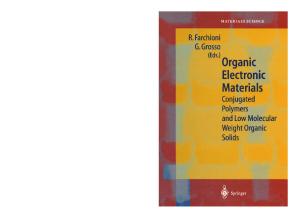Optically Transparent Conducting Polymers from Fused Heterocycles
- PDF / 173,630 Bytes
- 7 Pages / 612 x 792 pts (letter) Page_size
- 78 Downloads / 333 Views
0965-S12-14
Optically Transparent Conducting Polymers from Fused Heterocycles Mustafa Selman Yavuz1, Arvind Kumar1, Byoungchul Lee1, Jayesh G. Bokria1, Tanmoy Dey1, Venkataramanan Seshadri1, Yogesh Ner1, Zeki Buyukmumcu2, and Gregory A. Sotzing1 1 Department of Chemistry and Polymer Program, Institute of Materials Science, University of Connecticut, 97 N Eagleville Rd, Storrs, CT, 06269 2 Department of Chemistry, Erciyes University, Kayseri, Turkey
ABSTRACT We report electronic and optoelectronic properties of conducting polymers obtained from two different fused heterocycles, viz. thieno[3,4-b]furan (T34bF), and thieno[3,4-b]thiophene (T34bT). The three possible dimers of thieno[3,4-b]thiophene were also synthesized and the investigated by electrical and optical measurements. Aqueous dispersion polymerization of T34bT in the presence of poly(styrene sulfonic acid) as a template was also performed and shown to be water processable. Water soluble conducting polymer was also obtained via ring sulfonation of chemically or electrochemically prepared polythieno[3,4-b]thiophene [PT34bT]. The optical properties were tuned by varying the sulfonation level or by depositing different number of bilayers via layer-by-layer technique. Stable conjugated polymers with band gaps ranging from 0.8 to 1.6 eV were obtained and are reported herein. INTRODUCTION Research in the field of optically transparent conducting polymers continues to gain great attention due to their relatively low processing cost, light weight and flexibility as compared to their inorganic counterparts. Besides having found several applications in the field of electronic and optoelectronic devices, optically transparent conducting polymers are primarily used as a hole- injection layers in photovoltaics and light-emitting devices. Indium-doped tin oxide (ITO), an optically transparent inorganic conductor, is widely used in the ever growing market of display technology. Thus, the real goal of optically transparent conducting polymer resides in the replacement of ITO, where the benefits of polymer processability can be reaped. The challenges facing optically transparent conducting polymers include high conductivity, transparency in the entire visible region of the electromagnetic spectrum and stability in the doped or conductive state combined with processability. A stable conductor, Poly(ethylenedioxythiophene) (PEDOT) has been investigated as a potential material. Reduction of the band gap of the conducting polymer is one approach, thereby the π−π* electronic transition is completely shifted out of the visible region making the polymer transparent to the naked eye. Band gap reduction can be achieved by fusing a pro-aromatic ring onto a thiophene, thereby forcing the thiophene to attain the planar quinoid state, as demonstrated for poly(isothianaphthene) (PITN).1 PITN, although was a low band-gap polymer, was not stable in its conductive state. We thus combined the stability of PEDOT along with the low-band gap attributes of PITN and report poly(thieno[3,4-b]fura
Data Loading...











